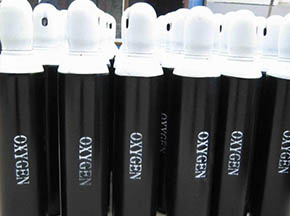
Oxygen is an industrial gas produced from the process of air separation. It comprises approximately 21% of the air we breathe. Oxygen is an active element which, although not being burnt supports combustion and reacts, directly or indirectly with all elements except the rare gases. Gaseous Oxygen is colorless, odorless and tasteless. At 14%-16% Oxygen in air, signs of O2 deficiencies begin to occur with an increase in the rate and depth of breathing. At 4% Oxygen even a little bit of breathing can cause unconsciousness.
Oxygen is an industrial gas produced from the process of air separation. It comprises approximately 21% of the air we breathe. Oxygen is an active element which, although not being burnt supports combustion and reacts, directly or indirectly with all elements except
the rare gases. Gaseous Oxygen is colorless, odorless and tasteless. At 14%-16% Oxygen in air, signs of O2 deficiencies begin to occur with an increase in the rate and depth of breathing. At 4% Oxygen even a little bit of breathing can cause unconsciousness.
Oxygen does not burn but it supports combustion. Many substances which do not normally burn in air only require a slight spark or moderate heat to set them aflame in the presence of an Oxygen enriched atmosphere. The best method of fighting an Oxygen supported fire is to shut off the Oxygen at its source.
Oxygen causes many substances to burn. Hence we must be extremely careful to keep all Oxygen piping and vessels clean. Grease and oil become highly flammable in the presence of Oxygen and must not be allowed to contaminate Oxygen piping or equipment. For this reason, special cleaning procedures using an approved cleaning agent are used to clean parts in Oxygen service.
Only specially designed accessories, specifically meant for being used in Oxygen services are used to maintain the mentioned parameters. These accessories are said to be Oxygen compatible. Oxygen compatible accessories include valves, gasket, valve packing, insulation, lubricants, piping materials design, accessory design, etc.
Since Oxygen is an invisible gas, it is impossible to see an atmosphere enriched in it. Therefore, atmospheric testing should always be performed prior to work in enclosed areas. The primary hazard of an enriched Oxygen atmosphere is fire. Clothing saturated with Oxygen is highly flammable and can be easily ignited. It should be removed if possible and aired out for at least 30 minutes.
Liquid Oxygen is pale blue in color, odorless and has a boiling point of -297oF (-183oC). When liquid Oxygen spills occur there is the danger that the liquid will saturate or mix with some combustible material and that the mixture is subject to ignition. Ignition can be caused by hot objects, sparks or the heat of compression such as a tire rolling over an asphalt surface.
An Oxygen spill area must be roped off or isolated so that no vehicles or personnel enter the area until the frost marks of the spill are completely gone.The National Fire Protection Association (NFPA) 704 standard rates compressed oxygen gas as nonhazardous to health, non-flammable, nonreactive, but an oxidizer. Refrigerated liquid oxygen (LOx) is given a health hazard rating of 3 (for increased risk of hyperoxia from condensed vapors, and for hazards common to cryogenic liquids such as frostbite). All other ratings remain the same as the compressed gas form.
Liquid oxygen spillages, if allowed to soak into organic matter, such as wood, petrochemicals, and asphalt can cause these materials to detonate unpredictably on subsequent mechanical impact. As with other cryogenic liquids, on contact with the human body, liquid oxygen can cause frostbites to the skin and the eyes.Liquid Oxygen expands rapidly when it evaporates to a gaseous state. One cubic foot of Liquid Oxygen expands to 861 cubic feet of gas at the same pressure.
CATEGORY AND DETAILS
Chemical Name :- O2
Specification
IS 309:2005
Offered Purity
99.5%
Cylinder Colour
Black
Packaging
The cylinders are available in 7 m3 capacity and 150 kg/cm2 pressure. Portable cryogenic containers
Application
O2 is used in the metal industry for producing steel, iron and metal-cutting applications. O2 injection in various kinds of furnaces (like open-hearth furnace, blast furnace, cupola furnace, smelters for glass and mineral wool, and lime and cement kilns) to enhance their capacity and to reduce energy requirements. Smelting times and energy consumption can be reduced by special oxy-oil or oxy-gas burners in electro-steel furnaces and induction smelters for Aluminium. High thermal efficiency and rapid combustion at 2800oC is achieved by “Oxy-fuel” burners. Allow greater use of scrap metal in electric arc furnaces. Make other metals such as copper, lead and zinc.
Read More